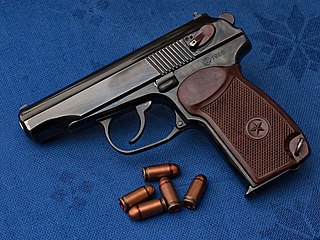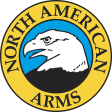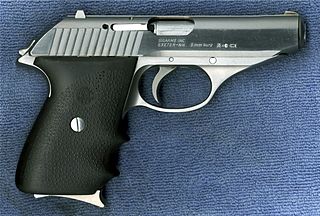
A semi-automatic pistol is a handgun that automatically ejects and loads cartridges in its chamber after every shot fired. Only one round of ammunition is fired each time the trigger is pulled, as the pistol's fire control group disconnects the trigger mechanism from the firing pin/striker until the trigger has been released and reset.

The .380 ACP (9×17mm) is a rimless, straight-walled pistol cartridge developed by firearms designer John Moses Browning. The cartridge headspaces on the mouth of the case. It was introduced in 1908 by Colt, for use in its new Colt Model 1908 pocket hammerless semi-automatic, and has been a popular self-defense cartridge ever since, seeing wide use in numerous handguns. Other names for .380 ACP include .380 Auto, 9×17mm, 9mm Browning, 9mm Corto, 9mm Kurz, 9mm Short, and 9mm Browning Court. It should not be confused with .38 ACP. The .380 ACP does not strictly conform to cartridge naming conventions, named after the diameter of the bullet, as the actual bullet diameter of the .380 ACP is .355 inches.

The Makarov pistol or PM is a Soviet semi-automatic pistol. Under the project leadership of Nikolay Fyodorovich Makarov, it became the Soviet Union's standard military and Militsiya side arm in 1951.

The Beretta Cheetah, also known by its original model name of "Series 81", is a line of compact blowback operated semi-automatic pistols designed and manufactured by Beretta of Italy. They were introduced in 1976 and include models in .32 ACP, .380 ACP and .22 LR. Beretta still manufactures the Cheetah in Italy with limited imports to the U.S. each year.

The Beretta 21A Bobcat is a semi-automatic pocket pistol designed by Beretta in Italy. Production began in the late 1984, solely in the Beretta U.S.A. facility in Accokeek, Maryland. It is a further development of the Beretta Model 20, whose production ended in 1985.

The Beretta 950 is a semi-automatic pistol designed and manufactured by Beretta since 1952. It builds on a long line of small and compact pocket pistols manufactured by Beretta for self-defense. It was intended to be a very simple and reliable pocket pistol.

.32 ACP is a centerfire pistol cartridge. It is a semi-rimmed, straight-walled cartridge developed by firearms designer John Browning, initially for use in the FN M1900 semi-automatic pistol. It was introduced in 1899 by Fabrique Nationale, and is also known as the 7.65×17mmSR Browning or 7.65 mm Browning Short.

The Walther PP series pistols are blowback-operated semi-automatic pistols, developed by the German arms manufacturer Carl Walther GmbH Sportwaffen.

The Thunder 380 is a lightweight, relatively small semi-automatic pistol series chambered in the popular .380 ACP caliber made by Argentine firearms manufacturer Bersa, S.A.

The Thunder 9 is a full-size semi-automatic handgun manufactured by Bersa at the Ramos Mejia production plant in Argentina. It is also sold under the name Firestorm or FS 9.

The Hi-Point Model JHP is a polymer-framed, semi-automatic, blowback-operated pistol manufactured by Hi-Point Firearms.

In American English, a pocket pistol is any small, pocket-sized semi-automatic pistol, and is suitable for concealed carry in a pocket or similar space.

The P-64 is a Polish semi-automatic pistol designed to fire the 9×18mm Makarov cartridge. The pistol was developed in the late 1950s at the Institute for Artillery Research by a team consisting of: W. Czepukajtis, R. Zimny, H. Adamczyk, M. Adamczyk, S. Kaczmarski and J. Pyzel. The P-64 is also known as the CZAK.

The Colt Model 1900 is a short-recoil operated "self-loading", or semi-automatic .38 caliber handgun introduced by Colt's Manufacturing Company at the turn of the 20th century. It also marked the introduction of .38 ACP, the round for which it is chambered, and was the first handgun to utilize short-recoil operation.

North American Arms is a United States company, headquartered in Provo, Utah, that manufactures pocket pistols and mini-revolvers, also called mouse guns. The company was originally named Rocky Mountain Arms when it was founded in 1972. In 1974 it was bought by new owners who renamed the company North American Manufacturing (NAM) and then North American Arms (NAA).

The SIG Sauer P230 is a small, semi-automatic handgun chambered in .32 ACP or .380 Auto. It was designed by SIG Sauer of Eckernförde, Germany. It was imported into the United States by SIGARMS in 1985. In 1996 it was replaced by the model P232.
The Colt Model 1903 Pocket Hammer was a short-recoil, semi-automatic pistol, designed by the American arms designer John Browning. It was a compact version of the Colt Model 1902 Sporting Model pistol derived from the original Colt M1900. The Colt M1902 Sporting Model and 1903 Pocket Hammer models differ significantly from the military-inspired Colt 1902 Military Model although they fire the same cartridge. Its design is in no way related to the Colt Model 1903 Pocket Hammerless or the FN Model 1903 pistol.
Llama Firearms, officially known as Llama-Gabilondo y Cia SA, was a Spanish arms company founded in 1904 under the name Gabilondo and Urresti. Its headquarters were in Eibar in the Basque Country, Spain, but they also had workshops during different times in Elgoibar and Vitoria. The company manufactured moderate-priced revolvers and self-chambering pistols in a wide variety of models. These were popular mainly in the European and Latin American export market, as well as domestically in Spain.
Bersa is an Argentine arms manufacturer, located in the city of Ramos Mejía in Argentina.

The Savage Model 1907 is a semi-automatic pocket pistol produced by the Savage Arms, from 1907 until 1920. It was chambered in .32 ACP and, from 1913 until 1920, in .380 ACP. Although smaller in size, it is derived from the .45 semi-automatic pistol Savage submitted to the 1906-1911 US Army trials to choose a new semi-automatic sidearm. After several years of testing the Savage pistol was one of two finalists but ultimately lost to the Colt entry, which became famous as the Colt Model 1911. A total of 181 of these .45 ACP pistols were returned to Savage after the testing and sold on the civilian market.

















